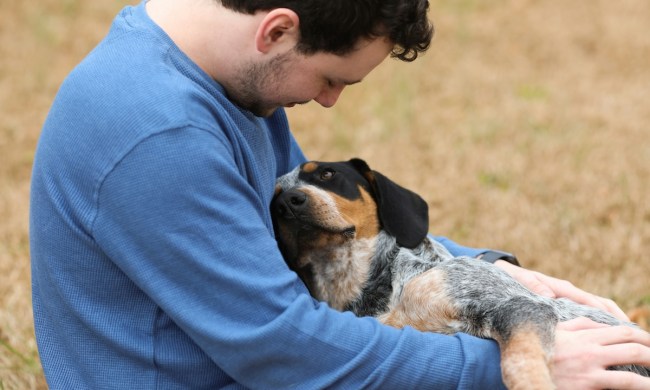Pet parents may know the potential dangers of certain foods, like chocolate, for pets. However, risks within a home — and outside of it — aren’t limited to pantry staples. Eating certain plants can also lead to short-term discomfort, long-term health issues, and even death. Holiday-favorite poinsettias are one of the more well-known examples of plants that are toxic to dogs.
There are others, including ones commonly found in gardens and bouquets each spring and summer. What about hydrangeas? Are hydrangeas poisonous to dogs? This one is a great question, given how ubiquitous hydrangeas are around the country. They thrive in various conditions and soils and add bulk and beauty to gardens — a true bang-for-your-buck plant for green thumbs, but what about pet parents? Here’s what to know about hydrangeas, toxicity, and dogs.
Are hydrangeas poisonous to dogs?

Yes, every part of hydrangeas is poisonous for dogs, including the bud, stem, flowers, and leaves. Hydrangeas contain a cyanogenic glycoside called amygdalin, which is toxic. Apple seeds and cherry pits have similar toxins. Eating part of a hydrangea can trigger what’s known as cyanide poisoning, which can make it more difficult for your dog’s body to send oxygen to the blood.
The leaves and flowers of a hydrangea usually have the highest levels of amygdalin, but Fido shouldn’t chow down on any part of this shrub. A dog would likely need to consume large quantities of hydrangeas to experience cyanide poisoning. It’s rare for dogs to experience severe side effects, including death, from eating pieces of this shrub. Still, pet parents will want to be mindful that no amount of hydrangea is safe for dogs to consume and they need to take practical steps.
Signs of hydrangea poisoning in dogs

Understanding the signs and symptoms of hydrangea poisoning is essential to ensure your pet receives prompt care. After all, you may miss your pet taking a bite of a hydrangea. Or you may see your pet eat hydrangea and receive instructions from your vet to monitor them at home for signs before bringing them in. Knowing what those are is essential. Signs of hydrangea poisoning in dogs can happen quickly — within 15 to 20 minutes of ingesting the shrub. They include:
- Vomiting
- Diarrhea
- Lethargy/fatigue
- Reduced or loss of appetite
Some of the more serious signs of hydrangea poisoning and indications your dog consumed a potentially fatally toxic amount are:
- Fast breathing
- Signs of pain (whining/whimpering)
- Overly excited
- Fever
- Drooling
- Fast heart rate
- Eyes watering
- Peeing or pooping in the home despite successful housebreaking
- Muscle spasms
- Gum discoloration (bright red or blue)
Most importantly, all these signs — severe and lesser — are red flags about your pet’s health.
What to do if your dog ate a hydrangea

We’re unsure how much hydrangea a dog needs to consume to experience severe or fatal side effects. Your best bet is to call your pet’s vet. The Pet Poison Helpline is (855) 764-7661 and can offer assistance, including information and emergency vet care in your area that’s currently open.
Bring any part of the plant that your pet ate to the vet with you. The vet can look at the plant to verify it’s a hydrangea and take the appropriate steps. Generally, vets will begin with a physical exam, including blood and urine, to rule out other health issues. Since a host of problems can trigger vomiting and diarrhea, they may also want to perform an X-ray of your dog’s tummy to confirm the hydrangea is to blame for these symptoms.
Your vet may induce vomiting — something you should never do at home — to reduce the amount of toxins your dog’s body absorbs. Alternatively, they may send you home to monitor your dog if they believe the hydrangea toxicity is mild. In this case, the vet may prescribe antinausea and antibiotic medications. You can give these to your pet at home, and they’ll help with vomiting and diarrhea.
Dogs that struggle to eat and drink may require an overnight stay for IV fluid therapy, which helps lower the risk of dehydration.
The outlook for hydrangea poisoning in dogs is usually good if treated quickly.
How to keep your dog safe from hydrangea poisoning

You can take steps to lower your dog’s risk of hydrangea poisoning, whether you have them in your garden or not. These practical steps include:
- Limit access to hydrangeas. Keep any hydrangeas inside your home where your pet can’t access them. Outside, gate off the garden area with this shrub or make them a front yard flower.
- Leash your dog. Ensure your dog is leashed when you walk by hydrangeas, and teach and instruct them to “leave it” if they show interest in one.
- Consider nontoxic replacements. You might opt for African violets and snake plants instead. These plants are nontoxic to dogs (though any plant carries the risk of a tummy ache).
Closing thoughts

Every part of a hydrangea is toxic to dogs. Still, hydrangea poisoning is rare because dogs have to consume a large quantity to experience it. And yet, we don’t know what qualifies as a “large quantity,” so your best bet is to keep your dog from eating a hydrangea and contact a vet or poison control right away if you see or suspect your dog ate part or all of a hydrangea.
Hydrangeas contain amygdalin, which can affect how their bodies use oxygen. More mild symptoms include vomiting and diarrhea, while severe ones include muscle spasms and gum discoloration. Treated quickly, the outlook for hydrangea poisoning is good.




